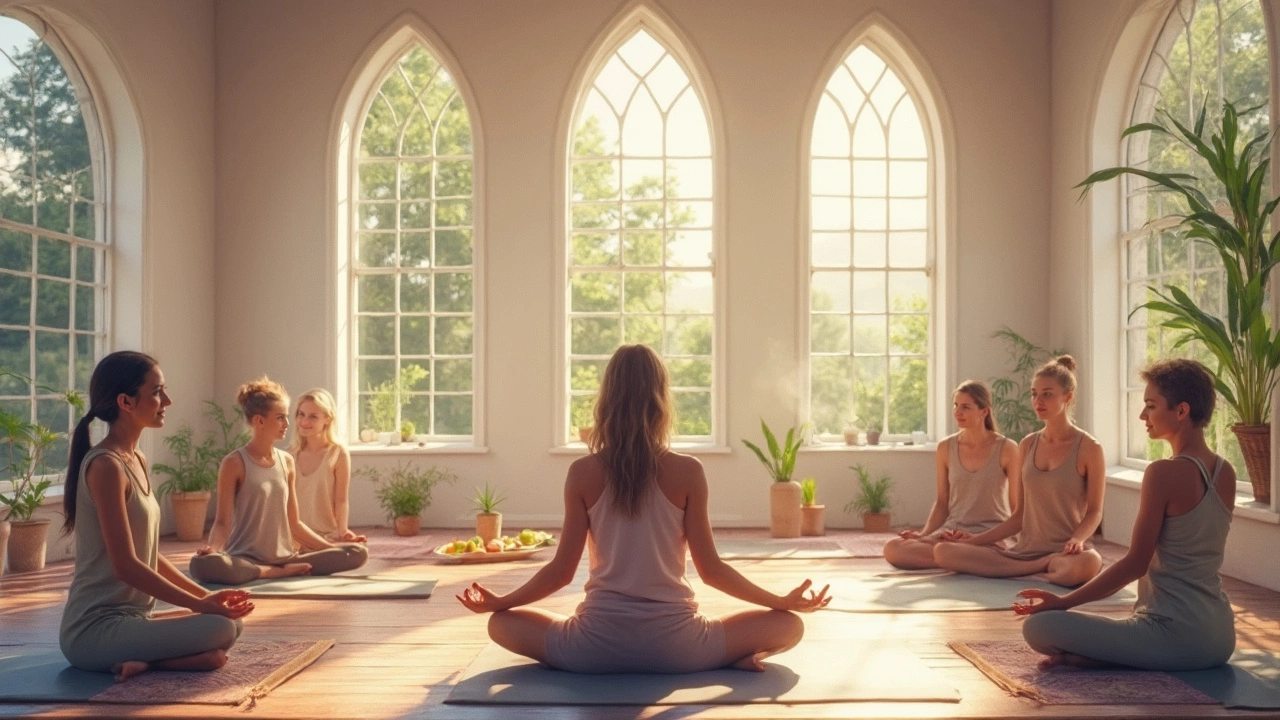
You might think yoga is all about twisting your body into pretzel shapes, but there's much more under the surface. At its core, yoga is built on five major principles, each one as essential as the last. Let's start with something we do all day without a second thought—breathing.
Breath control, or pranayama, is more than just taking a deep breath. It’s about controlling your inhalations and exhalations to boost your lung capacity and calm your mind. Not only can proper breathing techniques enhance your physical performance, but they also leave you feeling relaxed and focused. The next time you’re stressed, try a few minutes of mindful breathing—you might find it’s a game changer.
Breathing is something we do without thinking, yet in yoga, it's a practice to be mastered. Known as pranayama, it’s not just about air in and out. It’s harnessing the power of breath to enhance both body and mind.
First off, you might wonder why we should focus on breathing. Well, by controlling our breath, we can actually influence our physical state. Need to calm down quickly? Controlling your breath can lower your heart rate and bring a sense of peace. And hey, studies have shown that mindful breathing can improve concentration and reduce stress—major plus points in our hectic lives.
Okay, let's get actionable. How do you actually practice this? Here’s a simple guide to start:
This practice, when done regularly, brings a sense of calm, and who doesn’t need that?
| Benefits | Frequency |
|---|---|
| Reduced stress | 5 times a week |
| Increased lung capacity | Daily practice |
| Enhanced focus | 5 times a week |
Remember, improving your breath control isn't just about yoga sessions. Try applying these techniques when you feel overwhelmed, before a big meeting, or even when you're stuck in traffic. The more you incorporate it, the more benefits you’ll notice. So take that deep breath and dive in—your body and mind will thank you!
When it comes to yoga, relaxation isn't just a bonus – it's a core principle. At its heart, yoga encourages letting go of tension, both in the body and the mind. In a world that demands high energy around the clock, knowing how to relax can be a superpower. It’s not just about a five-minute corpse pose. There’s a whole world of techniques to explore.
Ever heard of Progressive Muscle Relaxation (PMR)? It’s a straightforward technique where you tense each muscle group and then slowly let go. You start from your toes, moving up to your scalp. Squeeze each muscle tight for a few seconds before releasing. This not only helps relieve physical tension but also heightens awareness of where you tend to hold stress.
Dream of a quiet beach or a serene forest but can't make it there? Guided imagery can take you there mentally. With this technique, someone—usually a yoga instructor with a soothing voice—guides you through a mental journey to a peaceful place. It sounds simple, but it can do wonders for anxiety and stress.
Remember the importance of breath control we talked about? Well, using a focus on your breath can be incredibly relaxing. In a quiet room, lie back, close your eyes, and breathe deeply. Pay attention to each breath, in and out. It's almost like giving your mind a mini-vacation.
Everyone talks about relaxation techniques, and for good reason. They not only help you unwind but also improve your mood and energy levels. Start small and see how these practices can fit into your everyday life—you might just be surprised at the benefits!

When you're practicing yoga, what you eat can significantly impact your energy levels and overall experience. Although the principles might vary slightly depending on cultural or personal preferences, the general consensus leans towards a diet that's clean, light, and balanced. Let’s break it down to make it digestible.
Dive into a diet rich in whole foods. Think unprocessed goodies like fruits, veggies, whole grains, nuts, and seeds. These foods help keep your body nourished and ready for your next yoga session. Processed foods, full of additives and preservatives, can leave you bloated and sluggish—the last thing you want when trying to achieve inner peace.
Timing your meals and snacks around your practice plays a crucial role. Eating a heavy meal right before a class can weigh you down. Consider eating a small, easily digestible snack, like a banana or a handful of almonds, if you need energy boosts before practice. Post-practice meals should be nutritious and balanced to help replenish your body.
Keeping hydrated is another essential aspect. Drinking plenty of water before and after your yoga session can help detoxify your system. But remember, drinking too much right before practice can be counterproductive, especially during rigorous practice involving a lot of twists and bends.
Everyone’s body is unique, so it’s important to find what works best for you. Listen to your body—sometimes it whispers before it screams. There's no one-size-fits-all in a yoga diet. Embrace moderation, mindful eating, and most importantly, enjoy the process of discovering what nourishes you the best.
Movement is fundamental to yoga. In the world of yoga, we call physical postures asanas, and they are essentially the foundation of most yoga practices. Each asana is designed not just to enhance flexibility but also to build strength and improve balance.
What's fascinating about asanas is their versatility. Whether you're a beginner or a seasoned yogi, there's always something new to explore. You've probably heard of some of the classics like Downward Dog or Tree Pose, but did you know there are over a thousand poses out there? And each one has its own set of benefits, targeting different muscles and improving different elements of your health.
Getting into the habit of practicing asanas regularly is key. Aim for at least 20-30 minutes of daily practice. You can start with basic poses and gradually move to more complex ones. Consistency is more important than intensity at the beginning, so listen to your body and don’t push yourself too hard.
Interested in tracking your improvements? Here’s a simple sample of how fast your flexibility might change:
| Time Period | Expected Improvement |
|---|---|
| 1 month | Basic flexibility and balance |
| 3 months | Greater muscle control and strength |
| 6 months | Enhanced technique and fluidity |
As you practice these yoga fundamentals, remember it's not just about the physical exercise. The focus and discipline you cultivate on your mat will seep into your daily life, helping you deal with stress and life's ups and downs more gracefully.